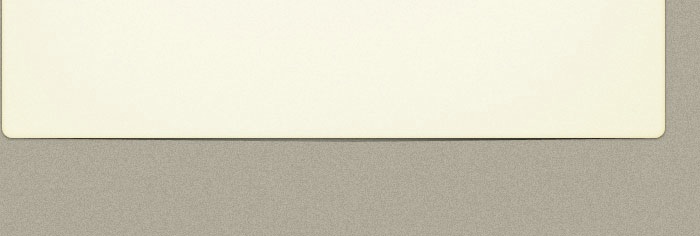Raffaellino was born in Colle, Borgo Sansepolcro. Fr. Ludovico da Pietralunga, in his guide (ca. 1575) to San Francesco, Assisi, mentions that Raffaellino had trained under Giovanni di Pietro, lo Spagna. Fr Ludovico was in a position to know this: he was close to Dono Doni (see below), who sometimes worked with Raffaellino, and who had also trained under lo Spagna.
Raffaellino is documented in Rome in 1520, immediately after the death of Raphael, when he was working under Giulio Romano in the Sala di Costantino of the Vatican Palace. When Giulio left Rome in 1524, Raffaellino returned to Borgo Sansepolcro.
Giorgio Vasari records that the young Cristofano Gherardi, il Doceno trained under Raffaellino in 1524. Vasari later refers to both of these younger artists as “friends and pupils”. He notes that, when Rosso il Fiorentino fled from Rome after the sack of 1527 and took refuge in Borgo Sansepolcro, Raffaellino transferred a commission to him, “so that he might leave some example of his handiwork in that place”.
Although based in Borgo Sansepolcro, Raffaellino travelled extensively, securing commissions throughout Umbria, Tuscany and the Marches.
Assisi
St Rufinus (1556)
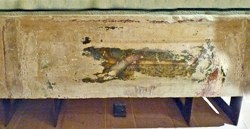
This damaged fresco of the supine St Rufinus on back of a Roman sarcophagus is associated with a payment made to “maestro Rafaello” (almost certainly Raffaellino del Colle) in 1556. At this time, the sarcophagus still contained the relics of St Rufinus in the crypt of San Rufino. The relics were translated to a new sarcophagus in 1586, at which point the empty Roman sarcophagus was moved to its present location, in the crypt of Bishop Ugone’s church.
Baptism of Christ (1556)
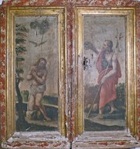
Volta Pinta (1556)
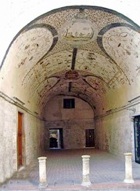
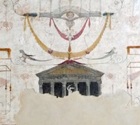
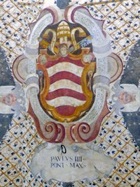
Città di Castello
Works in the Pinacoteca Comunale
The following panels that are attributed to Raffaellino del Colle are now in the Pinacoteca Comunale:
Annunciation (ca. 1528)
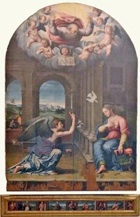
The main panel was transferred to the gallery in 1912. Three predella panels also here, each of which depicts three saints, probably belonged to this altarpiece.
Deposition (ca. 1552)
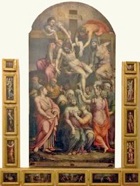
Agostino Tofanelli, the Director of the Musei Capitolini, Rome attempted to confiscate the altarpiece 1813, but (as Cristina Galassi - referenced below -has shown) the local authorities were able to resist because it was still in use in the church. (The relevant research by Christina Galassi is referenced below).
The panel was transferred to the gallery in 1912. A number of small panels that are also here (six depicting angels holding the instruments of the Passion and five depicting scenes from the Passion) were recently recognised as having come from this altarpiece, and are now exhibited beside it.
Annunciation (ca. 1559)
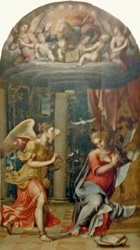
Assumption of the Virgin (1560)
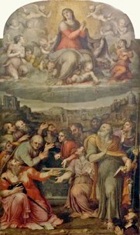
Presentation of the Virgin (ca. 1560)
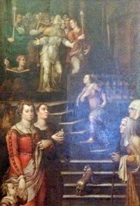
Madonna and Child with Saints (ca. 1530)
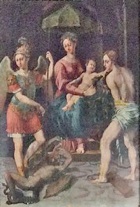
Gubbio
Works in San Pietro
The frescoes (1540) in the Cappella di San Benedetto (the 5th bay on the right) of the church of the Abbazia di San Pietro and the contemporary altarpiece are attributed to Raffaellino del Colle. The work corresponds to documented payments made in 1539 to “Rafaelle pintore e compangni”. The work was commissioned by the Nuti family, which owned the chapel.
-
✴The frescoes depict:
-
•St Benedict in glory with other saints, in the upper register;
-
•St Benedict receives St Placidus into his monastery, on the lower left; and
-
•St Benedict receives St Maurus into his monastery, on the lower right.
-
✴The altarpiece depicts the Adoration of the Magi.
Madonna with Child and Angels (1546)
This fresco, which forms the altarpiece in the 4th chapel on the left of San Domenico, is attributed to Raffaellino del Colle and [dated by inscription ??]
Perugia
Frescoes in Rocca Paolina (1543-4)
Giorgio Vasari reports that Lattanzio Pagani began the decoration of the newly built Rocca Paolina. Cristofano Gherardi, il Doceno (who was a close associate of Vasari) “not only assisted ... Lattanzio, but afterwards executed with his own hand the greater part of the best works that are painted in the apartments of that fortress, in which there also worked Raffaellino del Colle and Adone Doni of Assisi, an able and well-practised painter .... Tommaso [Bernabei, il] Papacello also worked there ...”
This is the only surviving record of the commissioning of the frescoes of Rocca Paolina. Paul III had built the fortress after his subjugation of the rebellious Perugians in 1540, so it is unsurprising that the team included no Perugian artists: indeed, apart from Dono Doni, all the artists came from outside Umbria. They were to spearhead the introduction of Mannerist art to the city of Perugino. Unfortunately, all of their work here was lost when the fortress was demolished in 1860.
Vasari is explicit the work had been commissioned by “Messer Tiberio Crispo, who was governor and castellan at that time”. A number of considerations suggest that the time in question was 1543-4:
-
✴Serafino Siepi, who described the surviving and frescoes in his guide of 1822, says that those in the chapel (which he attributed to Dono Doni) were dated by inscription to 1543;
-
✴Giorgo Vasari says that he called Cristofano Gherardi from Perugia to Rome in 1543, where he stayed for “many months”;
-
✴Raffaellino del Colle is documented in Perugia in June 1544;
-
✴Tiberio Crispo became a cardinal in December 1544, after which the title “Messer” would have been inappropriate; and
-
✴Giorgio Vasari called Cristofano Gherardi and Raffaellino del Colle (whom he describes as his “friends and pupils”) to Naples in 1545, albeit that Cristofano was too ill to respond.
If this is correct, Vasari’s reference to Tiberio Crispo as “governor and castellan” was either incorrect or perhaps was a reference to Tiberio Crispo’s position at Castel Sant’ Angelo, Rome in 1542-5. He energetically promoted the decoration of the Roman fortress during his tenure, and might also have had responsibilities at Rocca Paolina before his appointment as Cardinal Legate of Perugia (1545-8).
Holy Family with St John the Baptist (1560)
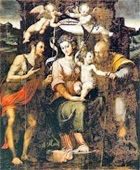
The altarpiece depicts the Madonna and Child enthroned with SS John the Baptist and Joseph, set in a landscape. St Joseph plays with the baby Jesus, and they both hold the flowering staff that is his traditional attribute of St Joseph. St John the Baptist seems to be reminding the Virgin of the baby’s fate, as two baby angels hold a crown above her head.
Madonna and Child with Saints (1563)
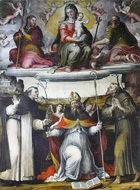
-
✴the Madonna and Child with SS James and Philip, above; and
-
✴SS Dominic, Augustine and Francis, below.
Read more:
M.Droghini, “Raffaellino del Colle”, (2005) Sant’ Angelo in Vado
The attempted requisition of the Deposition from Santa Marie delle Grazie, Città di Castello is discussed (on p. 110 and note 67, p. 124) in:
C. Galassi, “Il Tesoro Perduto: le Requisizioni Napoleoniche a Perugia e la Fortuna della Scuola Umbra in Francia tra 1797 e 1815”, (2004) Perugia
Return to Art in: Assisi; Città di Castello; Gubbio; Perugia.
Return to “Foreign” Painters in Umbria.
